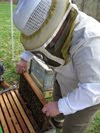 Fun Fact: Bees have pockets. Bees produce beeswax from their own bodies. On the underside of their abdomen are four pairs of wax glands. Under the wax glands are tiny pockets which hold the wax scales as they are being made.
Fun Fact: Bees have pockets. Bees produce beeswax from their own bodies. On the underside of their abdomen are four pairs of wax glands. Under the wax glands are tiny pockets which hold the wax scales as they are being made.When a wax scale is ready for use, the bee takes it out of the pocket by spiking it on the strong hairs of her back legs, and then passes it to the jaws.
There it is chewed, and other materials may be mixed with the wax. When it is soft, the worker puts it into place on the comb being built.
Source: Life of the Honey-bee - A Ladybird Natural History Book










